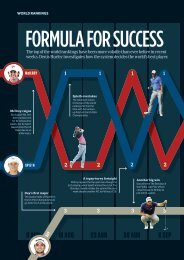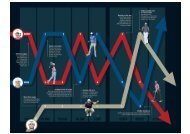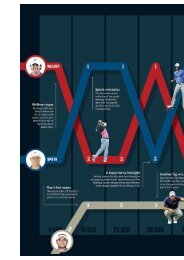TG_339_PREVIEW.pdf
- No tags were found...
Create successful ePaper yourself
Turn your PDF publications into a flip-book with our unique Google optimized e-Paper software.
TODAY’S GOLFER OCTOBER 2015 (SEPTEMBER 3-SEPTEMBER 30) <strong>339</strong><br />
WWW.TODAYSGOLFER.CO.UK<br />
OCTOBER 2015 ISSUE <strong>339</strong> SEPT 3-SEPT 30 £4.5
DRILLS<br />
Six super slice fixes<br />
Cut out that power-sapping slice with one of these quick fixes<br />
Fault: You regularly slice the ball.<br />
Fix: It is the most common miss among<br />
amateur golfers – the high slice. It costs you<br />
distance and control but, most frustratingly of<br />
all, you don’t know why you do it. I see it in<br />
around 75 per cent of people I teach and use<br />
one or two of these six drills with each of them<br />
to help eliminate this miss. These quick and<br />
simple tips are designed to give you the feelings<br />
in your set-up or swing that allow you to hit a<br />
straighter and more powerful flight when out on<br />
the course and under pressure.<br />
1. Face angle: Close it<br />
Set up with your feet aligned<br />
to the target and your<br />
clubface slightly closed to this<br />
line. From this address<br />
position make a real effort to<br />
swing out to the right and<br />
away from your body. This<br />
encourages an angle of attack<br />
more from the inside.<br />
2. PATH: FROM THE INSIDE<br />
<strong>TG</strong> TOP 50<br />
KEVIN FLYNN<br />
TOURNERBURY GC, HANTS<br />
Fellow of the<br />
PGA and a<br />
European<br />
Golf<br />
Development<br />
Consultant.<br />
This is a classic and really effective drill.<br />
Place an object directly behind or just<br />
outside your ball and make your swing.<br />
This forces an in-to-out attack as the<br />
opposite will see you hit the object.<br />
34 ISSUE <strong>339</strong> TODAYSGOLFER.CO.UK
Fault<br />
Fixer<br />
3. WEIGHT: ON YOUR HEELS 4. TAKEAWAY: ARMS CLOSE<br />
Most slicers have their weight too much towards their toes,<br />
creating a swing that is too steep. A great way to flatten out<br />
that swing plane is to place a ball under your back foot. This<br />
encourages you to move the club further behind you in the<br />
backswing, making it easier to swing from the inside.<br />
A big gap between your arms and your body on the first<br />
move back will likely result in a steep angle of attack<br />
coming from the outside back in to the ball causing you to<br />
cut across it. Focus on keeping your arms close to your<br />
body during the takeaway to avoid it.<br />
5. BACKSWING: RIGHT FOOT OUT 6. ROTATION: FULL TURN<br />
A reverse pivot is another slice cause. This is where you favour<br />
your lead side during the backswing and your back side in the<br />
through swing. It should be the other way around. Turning<br />
your back foot out will make it easier for you to load your right<br />
side (right-handers) on the way back.<br />
A full rotation on the way back allows you to properly load<br />
your right side for power. Anything short makes you more<br />
likely to throw your hands at the ball and come ‘over the top’.<br />
Imagine your clubhead has to break through a pane of glass<br />
at the top of your swing.<br />
100s MORE TIPS<br />
www.todaysgolfer.co.uk/tips<br />
TODAYSGOLFER.CO.UK ISSUE <strong>339</strong> 35
RYDER CUP RELIVED<br />
‘That shot is the<br />
first thing I talk<br />
about... especially<br />
in America’<br />
A year on from that wedge, Jamie Donaldson is in<br />
no hurry for anyone to forget his magic moment<br />
WORDS ROB JERRAM PICTURES ANGUS MURRAY, GETTY IMAGES<br />
ime flies when you’re having fun,<br />
T<br />
so it’s little wonder a year has past in<br />
the blink of an eye for Ryder Cup<br />
hero Jamie Donaldson.<br />
Incredibly, it’s already 12 months since the<br />
Welshman’s sublime wedge shot saw off<br />
Keegan Bradley to seal a third-straight Ryder<br />
Cup for Europe and spark jubilant scenes all<br />
around Gleneagles’ PGA Centenary Course.<br />
It’s perhaps unsurprising that the season<br />
that has followed hasn’t reached the same<br />
heights for the likeable 39-year-old, but with<br />
qualifying now underway for the team that<br />
Darren Clarke will lead to Hazeltine next<br />
September, the world No.42 is desperate to<br />
ensure his performance wasn’t a one off.<br />
We returned to the 15th hole – and the<br />
exact spot where Donaldson secured glory –<br />
to reminisce about that week, reflect on his<br />
season and look ahead to<br />
Europe’s defence.<br />
A year on, are you<br />
ready to talk about<br />
something else?<br />
No, thanks! It’s the<br />
highlight of my career<br />
so far. It’s still the first<br />
thing I talk about! I’ll<br />
never get bored of talking<br />
about it, especially in<br />
America! I spent four months<br />
there this year and they didn’t<br />
want me to talk about it – I<br />
still did (laughs).<br />
How have the American players and fans<br />
reacted to you this season?<br />
I’m still getting bits and bobs of abuse from<br />
the crowds, but I’ve enjoyed the stick from the<br />
fans and enjoyed winding them up in return –<br />
for the most part it’s done in good jest. What<br />
is clear is how frustrated the Americans are<br />
that they’re not winning the Ryder Cup, which<br />
is great for us, but awful for them. The players<br />
are obviously the same – Keegan and all of<br />
the US team said well done when I saw them<br />
in the weeks afterwards. But those guys are<br />
winners and they want to turn things around.<br />
Mentioning Keegan, how aware were you<br />
that it was coming down to your match?<br />
It had been building from the 11th. Crowds<br />
were gathering every hole and suddenly on<br />
the 15th tee it looked as though everyone that<br />
had been watching was there, trying to get a<br />
view. Being out at number 10 I’d always felt<br />
that was a possibility. Captain McGinley had<br />
said as much when he told me where I was<br />
playing. I remember walking from the tee and<br />
there were 40,000 people on this hole. We<br />
don’t get that kind of arena anywhere else in<br />
world golf. It’s something I’ll never forget.<br />
I imagine you’ve watched it back a lot, but<br />
what can you remember of that moment?<br />
(Laughing) Yeah, one or two hundred times.<br />
Sky replayed the whole Ryder Cup at<br />
Christmas and I kept putting it on!<br />
I’d missed a putt to win on 14, but put that<br />
out of my head and hit a perfect drive – ➔
Point man<br />
Donaldson<br />
returns to the<br />
spot where he<br />
sealed victory.
SRIXON<br />
Action for the masses<br />
All-new Z-355 range is designed specifically for the game improver<br />
rixon isn’t a name you instantly<br />
S<br />
associate with game-improvement<br />
clubs. We see Graeme McDowell,<br />
Keegan Bradley and other Tour players<br />
using Srixon gear – but now they want to<br />
seriously improve your game too with the<br />
all-new Z-355 range.<br />
Designed specifically for club golfers,<br />
Srixon has cleverly adopted ‘Action Mass’<br />
technology throughout the range. It means<br />
the clubhead is heavier than normal but<br />
the shaft is lighter, giving the capability to<br />
generate more kinetic energy at impact.<br />
So, swing the club at the same speed as<br />
you usually do and the club is travelling<br />
faster when you hit the ball – and more<br />
speed equates to more yards. This is the<br />
full story of Srixon’s new range...<br />
Z-355 driver<br />
Action Mass Technology<br />
The headweight is heavier so there is<br />
more ‘meat’ behind the ball at impact<br />
but incredibly the overall weight (head,<br />
shaft and grip combined) is lighter. This<br />
is achieved by using a shaft specifically<br />
designed for the purpose of raising the<br />
‘Balance Point’ to counteract the<br />
heavier head, which is all done with<br />
some clever engineering tricks inside<br />
the shaft.<br />
Ti Cup Face<br />
There’s no point in making a golf club as<br />
quick as possible if you then lose ball<br />
speed when shots are hit off-centre. A ‘Cup<br />
Face’ enlarges the hot zone area in the<br />
centre of the face as there’s no limiting<br />
joints which add weight and lower MOI<br />
where the face meets the driver body.<br />
Miyazaki Jinsoku Shaft<br />
The Japanese are super clever when it<br />
comes to producing graphite shafts and<br />
the 355’s premium Miyazaki Jinsoku is no<br />
exception. By tinkering with the wall<br />
thickness and profile of the shaft, Srixon<br />
claim this is a speed-obsessed, ultra-high<br />
balance point shaft that maintains its<br />
stability for maximum speed transfer<br />
and control.<br />
Adjustability<br />
It seems no self respecting driver is<br />
complete nowadays unless it’s able to be<br />
tuned to your own game. Well the 355 may<br />
be aimed at game-improvers, but it holds<br />
its own when it comes to adjustability.<br />
Tinker and tune to your heart’s content<br />
with 12 different positions which give you<br />
options over loft, lie and face angle.<br />
Z-355 irons<br />
Tour VT sole<br />
Srixon have a history of sculpting the soles<br />
of their irons to improve turf interaction<br />
A proper steel<br />
Nippon NS Pro<br />
950 DST shaft is<br />
a premium steel<br />
offering and does<br />
a similar job to the<br />
Miyazaki Jinsoku.<br />
Twin win<br />
A larger head but less<br />
weight being wasted<br />
supporting the ‘MAX<br />
COR Faces’ leads to an<br />
increase in MOI.<br />
94 ISSUE <strong>339</strong> TODAYSGOLFER.CO.UK
New<br />
Gear<br />
depending on the player the iron is<br />
aimed at. The 355’s Tour VT Sole has<br />
less trailing-edge bounce, meaning 43<br />
per cent less time interacting with the<br />
turf at impact; this limits the loss of club<br />
speed and can improve dispersion<br />
accuracy. Srixon’s engineers haven’t<br />
stopped there though – they’ve also<br />
increased the leading-edge bounce,<br />
making the iron less likely to ‘dig’ at<br />
impact. This, amazingly, can reduce club<br />
speed loss by up to 24 per cent.<br />
Max COR faces<br />
When you are looking to design a set of<br />
irons to maximise a game-improvement<br />
golfer’s performance, you have to dig<br />
deep into the engineering tool box.<br />
Srixon have done just that with the<br />
4-iron to the 7-iron, where they’ve used a<br />
super high spring steel face similar to<br />
that in a ‘Speed Channel’ fairway wood<br />
or hybrid. This improves ball speed on<br />
the mid-to-long irons, which is the area<br />
most likely to hurt the scores of club<br />
golfers. In the short irons – where the<br />
premium is much more on accuracy –<br />
the 355s revert to traditional one-piece<br />
cast heads.<br />
Weighting game<br />
Previous ‘super<br />
lightweight’ clubs<br />
were criticised<br />
for a loss in feel<br />
but the Z-355s<br />
address this.<br />
Action Mass Technology<br />
The idea of heavier clubheads but lighter<br />
overall weights is as relevant in your<br />
irons as it is your driver. The higher<br />
balance-point shaft runs through the set,<br />
allowing engineers to play their<br />
balancing tricks and create more<br />
clubhead momentum at impact.<br />
Premium shafts<br />
You don’t have to play graphite shafts to<br />
get the benefit of all the technology that<br />
Srixon has worked so hard to create. If<br />
you’re a steel shaft advocate then the<br />
Nippon NS Pro 950 DST shaft is a<br />
premium steel offering.<br />
Larger head, higher MOI<br />
The 355s have a larger head than<br />
Srixon’s forged offerings, which is a real<br />
benefit to the club golfer. That said, the<br />
offset is not massive as with some<br />
game-improvement irons, so they have a<br />
really attractive look to them.<br />
● Details: The Z-355s will be in stores<br />
from mid-September, priced at £279 for<br />
the driver and £499 (s)/£549 (g) for the<br />
irons. www.srixon.co.uk<br />
Z-355 fairway<br />
and hybrid<br />
Low-profile head shape<br />
and draw-to-neutral bias<br />
rixon’s ‘Action Mass’ technology<br />
plays just as important a role in<br />
S<br />
the fairways and hybrids as it does<br />
in the driver and irons. Also expect a lowprofile<br />
shaped head which helps flight the<br />
ball from the fairway or rough as well as a<br />
draw-to-neutral bias, which is perfect for<br />
its target club golfer audience.<br />
● Details: RRP £179 fairway, £159 hybrid.<br />
Super gameimprover<br />
iron<br />
More offset and bigger<br />
head boosts forgiveness<br />
f you’ve read all of this thinking<br />
“sounds good, but my game<br />
I<br />
needs more help”, then Srixon<br />
have thought of you, too. The Z-155s<br />
benefit from the same technology as the<br />
355s, but are just a bit bigger and have<br />
more offset to help you flight the ball well.<br />
These are ultra-forgiving clubs.<br />
● Details: RRP 5-PW £499 (s), £549 (g).<br />
TODAYSGOLFER.CO.UK ISSUE <strong>339</strong> 95
GOING THE<br />
DISTANCE<br />
Three formats of distance measuring devices,<br />
tested for ease of use, accuracy and value<br />
WORDS SIMON DADDOW PICTURES TOM CRITCHELL, HOWARD BOYLAN<br />
T H E<br />
T E C H<br />
I S S U E<br />
98
THE TEST<br />
Made to<br />
measure<br />
Devices for eye,<br />
wrist and palm<br />
were compared.<br />
t’s not long since yardage<br />
I<br />
books and marker posts were<br />
the only help golfers got<br />
plotting their way around a course.<br />
Things have changed massively over<br />
the last five years and now distance<br />
measuring devices feature in most<br />
golfers’ bags. But with the increasing<br />
choice, how do you decide which best<br />
suits you and your game? Handheld<br />
GPS, laser rangefinder or a GPS watch,<br />
all have their benefits – but they also<br />
have their drawbacks, and our test gets<br />
to the bottom of this.<br />
It also addresses another major<br />
issue; ease of use. We live in an age<br />
when we buy an iPhone and use it<br />
straight out the box – so is it too much<br />
to expect similar intuitiveness from a<br />
GPS system?<br />
In answering these questions, our<br />
test will help you whittle down your<br />
best options – and pick your perfect<br />
distance measuring device.<br />
How we did the test<br />
We asked manufacturers to send us<br />
their most recent GPS watches,<br />
handhelds and rangefinders. We<br />
divided them among the <strong>TG</strong> team and<br />
asked everyone to use them over at<br />
least five rounds. Equipment Editor<br />
Simon Daddow also spent a day<br />
walking a course comparing<br />
measurements to gauge accuracy and<br />
ensure each device passed through the<br />
same pair of hands for direct<br />
comparison. Finally we asked you, the<br />
<strong>TG</strong> reader, for your recommendations.<br />
By putting all of our thoughts together<br />
we came up with the devices we felt<br />
you should be considering in 2015.<br />
➔<br />
TODAYSGOLFER.CO.UK ISSUE <strong>339</strong><br />
99
The future for... Equipment<br />
Alan Hocknell, Head of R&D at Callaway, reveals how digital<br />
tech, new materials and 3D printing might change our clubs<br />
DIGITAL EXTRAS<br />
“Society as a whole is<br />
using more wearable<br />
technology to quantify<br />
numbers, so I anticipate<br />
golf will go this way,”<br />
says Hocknell.<br />
CLEVER FITTING<br />
“Smarter clubs giving<br />
digital info means we<br />
could put together a set<br />
for any individual with<br />
specific lofts, lengths etc<br />
that might be completely<br />
different for each of the<br />
four guys in a fourball.”<br />
TWO RULES? UNLIKELY<br />
Dean Knuth, the man who devised<br />
the USGA’s course and slope rating<br />
systems, a USGA administrator for 16<br />
years, and now the owner of a clubmaking<br />
firm, warns people not to hold<br />
their breath waiting for two sets of<br />
rules, or ‘bifurcation’. “The USGA will<br />
never create different rules for pros<br />
and amateurs,” he says. “They just<br />
aren’t at all interested.”<br />
NEW MATERIALS<br />
Callaway’s new Great Big<br />
Bertha features multiple<br />
materials in its design, but<br />
Hocknell and his team are<br />
constantly looking for new<br />
ones that are light, strong<br />
and flexible.<br />
3D PRINTED<br />
Flight of fancy? Not<br />
according to Hocknell,<br />
but only “when the<br />
capability of consumers<br />
to print at home is<br />
ubiquitous.”
THE FUTURE OF GOLF<br />
ith ultra-strict limits on size, face<br />
springiness and adjustability, golf<br />
W<br />
designers are looking at aerodynamics,<br />
materials and digital innovations to create the<br />
clubs of the future. We spoke exclusively to Alan<br />
Hocknell – Callaway’s Head of R&D and the<br />
man responsible for the return of the Great Big<br />
Bertha – to find out what might be in store...<br />
In 10 years’ time I don’t think drivers will have<br />
lasers, tiny rocket engines or any weird moving<br />
parts. Due to the limitations of the current<br />
rules, we have to design inside a governed<br />
space – so I imagine a driver head will look a<br />
lot like it does today.<br />
New materials and aerodynamics could<br />
change the way we design and build new<br />
drivers. New technology might mean the driver<br />
head could look a bit different in terms of<br />
cosmetics, like the square-headed FT-i we<br />
created in 2006. That driver was incredibly<br />
straight, but aerodynamically very slow.<br />
‘Connectedness’ is a huge area for growth in<br />
the future. At Callaway we are proud to have<br />
been involved with the development of Arccos,<br />
a digital system that connects to your clubs<br />
and communicates with your iPhone. It enables<br />
you to build a sophisticated picture of your<br />
game automatically. That allows for analysis<br />
like never before.<br />
Ultimately I’d love to fit golfers for new clubs<br />
based on data garnered from how they play on<br />
the golf course, rather than players basing their<br />
buying decisions on a few mighty blows in a<br />
fitting bay of their local driving range on a<br />
Saturday afternoon – when they may or may<br />
not be swinging the club at their best.<br />
We are working on some interesting new<br />
materials and manufacturing processes which<br />
could give significant gains like we saw when<br />
Callaway pioneered carbon-fibre technology.<br />
I hope we are the first to harness them for golf,<br />
but as of yet we haven’t been able to use them<br />
in a form that is suitable for a club.<br />
Our primary goal with these new materials is<br />
improving clubhead speed and contact<br />
efficiency between club and ball. We are<br />
looking for definite properties in each of these<br />
materials... light, strong and flexible are all<br />
great qualities for golf club<br />
design.<br />
Technically, there is<br />
nothing stopping<br />
us building a<br />
560cc nonconforming<br />
driver<br />
– we certainly know<br />
how to. Callaway in the<br />
past made the ERC, which was non-conforming<br />
in the US, but the No.1 selling driver in Europe<br />
and Japan. Maybe opinions have changed – or<br />
will change – in the future.<br />
There would be an interested audience if it<br />
could be shown that average golfers have more<br />
fun using non-conforming equipment. There<br />
would need to be plenty of support from the<br />
influential groups (rules bodies, PGA pros etc)<br />
and any advance would need to not threaten<br />
the basic skill requirements of the game. There<br />
are also practical hurdles to get over. For<br />
example, here in the USA golfers get a<br />
handicap based on every round they play, not<br />
just competition rounds. So if they used a nonconforming<br />
club, would they need two<br />
handicaps? Conforming and non-conforming?<br />
Non-conforming equipment carries a stigma –<br />
that you showed up intending to break the<br />
rules. Sellers and owners of non-conforming<br />
equipment would need to get past this. In Asia<br />
there is already a market for non-conforming<br />
equipment among golfers, who choose to play<br />
by their own rules.<br />
We 3D print metal parts of golf clubs today and<br />
it’s amazing technology! But the parts that<br />
come off the machine still need quite a lot of<br />
work before they are functional and it’s also very<br />
expensive. So the concept of golfers printing<br />
their own driver on a 3D printer is incredible.<br />
Digital technology will help. Clubs that are<br />
much smarter than anything around today<br />
could help measure each golfer’s game DNA.<br />
We as a manufacturer could use this<br />
information to design clubs which would be<br />
customised in many more ways than today.<br />
It’s my job to think what golf clubs might look<br />
like in 2020. We have a pretty solid plan<br />
through 2018, but we’re always looking for<br />
something disruptive, so our strategy is to be<br />
very agile and adaptable to new things. New<br />
technologies take time to develop – for example<br />
our forged composite material was in<br />
development for around four years before it<br />
was used in production.<br />
If you want to see tour players<br />
of the future, look at some<br />
juniors right now.<br />
Some of them will<br />
frighten you with how<br />
far they hit the ball.<br />
They have no fear, they<br />
have access to great<br />
fitted equipment, great<br />
coaching and are fit. Not all<br />
will reach 6ft 8in, but they’ll<br />
drive the ball very efficiently –<br />
and putt like wizards.<br />
Don’t forget<br />
the flatstick<br />
Austie Rollinson, lead<br />
designer at Odyssey,<br />
shares some insight<br />
● Lots to learn<br />
We are constantly learning about<br />
the physics of putting. The better<br />
we understand the dynamics of<br />
impact, face rebound speeds,<br />
acoustics, centre of gravity<br />
locations, moment-of-inertia values<br />
and of visual alignment aspects, the<br />
better we can build putters of the<br />
future. All of these aspects are just<br />
as important in a putter as they are<br />
in a driver or set of irons.<br />
● It’s got to look good<br />
New putter designs can’t look like<br />
science experiments. But we like<br />
to innovate around how a putter<br />
looks at address. The golfer wants<br />
a comforting look behind the ball, a<br />
look which breeds confidence every<br />
time they pull out the flatstick.<br />
● Multiple materials<br />
Divorcing the shape of the putter<br />
from the mass properties gives<br />
design freedom to optimise both<br />
independently. Utilising multiple<br />
materials such as steel, tungsten,<br />
urethanes and plastics allows<br />
us to constantly evolve putter<br />
designs that perform better for the<br />
golfer. Different materials mean<br />
we become less constrained, so<br />
our search for new materials is a<br />
continual process.<br />
● Don’t get boxed in<br />
We get excited about coming into<br />
work everyday to design putters<br />
that push the limits of convention.<br />
We never want to lose sight of<br />
the traditions of the game, but<br />
challenging what a putter should<br />
look like and how it should perform<br />
is part of our philosophy. ➔<br />
TODAYSGOLFER.CO.UK ISSUE <strong>339</strong> 55
T H E<br />
T E C H<br />
I S S U E<br />
Board<br />
games<br />
Could you see yourself using<br />
one of these in future? It’s<br />
tipped to be the new<br />
way round a course –<br />
so we put it to the test<br />
WORDS ROB Mc GARR PICTURES ANGUS MURRAY<br />
Surf’s up<br />
Golf Board<br />
has been<br />
designed by a<br />
former surfer.
Your personal<br />
Lessons<br />
with Lee<br />
Westwood has launched a new app that lets you<br />
compare your swing to his... and improve your technique<br />
WORDS LEE WESTWOOD, WITH PETER MASTERS PICTURES BOB ATKINS<br />
T H E<br />
T E C H<br />
I S S U E<br />
utting together software that lets<br />
P<br />
you compare swings, checking<br />
positions and tempo, was<br />
appealing to me because I’m a very visual<br />
person. I could see the benefits of placing<br />
two swings together so that you can see<br />
where you might be going wrong. When it’s<br />
there in front of you, there’s less need for<br />
complicated technical advice. It’s true to say<br />
in golf that on many occasions what you<br />
think you’re doing, may not be what you’re<br />
actually doing. This is why this works. A<br />
club player can select a club and shot<br />
direction and record their swing with me at<br />
their side, as if I’m standing right there with<br />
you on the tee hitting balls! Over the<br />
next six pages, I’ll show you the<br />
swing positions you want to be<br />
in to hit the ball long and<br />
straight. My app goes into<br />
more detail on each... and<br />
even lets you compare<br />
my swing moves to<br />
your own as you<br />
develop them. ➔

















